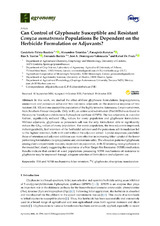Can Control of Glyphosate Susceptible and Resistant Conyza sumatrensis Populations Be Dependent on the Herbicide Formulation or Adjuvants?
Autor
Palma-Bautista, Candelario
Tataridas, Alexandros
Kanatas, Panagiotis
Travlos, Ilias S.
Bastida, Fernando
Domínguez-Valenzuela, José Alfredo
Prado, Rafael de
Editor
MDPIFecha
2020Materia
TSR and NTSR mechanismsFoliar retention
14C-glyphosate
Absorption
Translocation
METS:
Mostrar el registro METSPREMIS:
Mostrar el registro PREMISMetadatos
Mostrar el registro completo del ítemResumen
In this work, we studied the effect of three glyphosate formulations (isopropylamine, ammonium and potassium salts) and two non-ionic adjuvants on the resistance response of two resistant (R1, R2) and one susceptible population of the highly invasive Asteraceae, Conyza sumatrensis, from Southern France vineyards. Only in R1, an amino acid substitution (Pro106Thr) was found in the enzyme 5-enolpyruvylshikimate-3-phosphate synthase (EPSPS). The two adjuvants, in a similar fashion, significantly reduced GR50 values for every population and glyphosate formulation. Without adjuvants, glyphosate as potassium salt was the only formulation able to significantly reduce the GR50 values of every population. For every population, the two adjuvants improved, indistinguishably, leaf retention of the herbicidal solution and the potassium salt formulation led to the highest retention, both with and without the adjuvant added. Uptake responses paralleled those of retention and adjuvant addition was more effective in increasing foliar uptake of the lower performing formulations (isopropylamine and ammonium salts). The allocation pattern of glyphosate among plant compartments was only dependent on population, with R2 retaining most glyphosate in the treated leaf, clearly suggesting the occurrence of a Non-Target Site Resistance (NTSR) mechanism. Results indicate that control of weed populations possessing NTSR mechanisms of resistance to glyphosate may be improved through adequate selection of formulation and adjuvant use.

